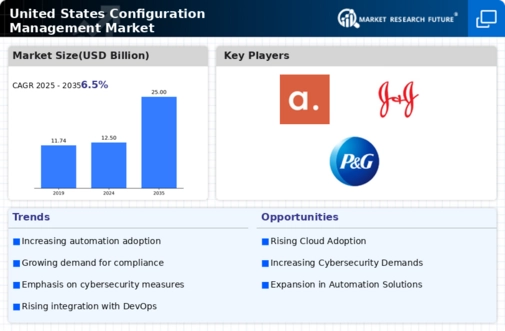Growing Cybersecurity Threats
The configuration management market is being significantly impacted by the increasing prevalence of cybersecurity threats. As organizations face a growing number of cyberattacks, the need for robust security measures in configuration management becomes paramount. Effective configuration management practices can help mitigate risks by ensuring that systems are securely configured and vulnerabilities are promptly addressed. Recent studies indicate that organizations with strong configuration management processes experience 40% fewer security incidents. This heightened awareness of cybersecurity risks is driving investments in configuration management solutions that incorporate security features, thereby fostering growth in the market. As threats evolve, the configuration management market is likely to adapt and innovate to meet these challenges.
Emergence of Advanced Analytics
The configuration management market is witnessing a transformative shift due to the emergence of advanced analytics and machine learning technologies. These innovations enable organizations to gain deeper insights into their IT environments, facilitating proactive management of configurations. By leveraging data analytics, companies can identify patterns and anomalies, leading to improved decision-making and risk management. It is estimated that organizations utilizing advanced analytics in their configuration management processes can enhance operational efficiency by up to 25%. This trend is particularly relevant in industries such as telecommunications and manufacturing, where complex systems require sophisticated management solutions. As the demand for data-driven decision-making grows, the configuration management market is likely to expand.
Regulatory Compliance Pressures
The configuration management market is increasingly shaped by the pressures of regulatory compliance across various sectors. Organizations are required to adhere to stringent regulations, particularly in industries such as finance, healthcare, and energy. Failure to comply can result in substantial fines and reputational damage. As a result, businesses are investing in configuration management solutions that ensure compliance with industry standards and regulations. Recent reports suggest that compliance-related investments in IT are expected to grow by 15% annually, further propelling the configuration management market. This focus on compliance not only drives demand for configuration management tools but also emphasizes the need for continuous monitoring and auditing capabilities.
Rising Demand for IT Efficiency
The configuration management market is experiencing a notable surge in demand driven by the need for enhanced IT efficiency. Organizations are increasingly recognizing the importance of streamlining their IT operations to reduce costs and improve service delivery. According to recent data, companies that implement effective configuration management practices can achieve up to a 30% reduction in operational costs. This trend is particularly evident in sectors such as finance and healthcare, where regulatory compliance and operational efficiency are paramount. As businesses strive to optimize their IT resources, the configuration management market is likely to see continued growth, with investments in tools and solutions that facilitate automation and integration into existing workflows.
Increased Focus on Cloud Adoption
The configuration management market is significantly influenced by the accelerated adoption of cloud technologies across various industries. As organizations migrate to cloud environments, the complexity of managing configurations increases, necessitating robust configuration management solutions. Recent statistics indicate that over 70% of enterprises in the US are utilizing cloud services, which creates a pressing need for effective configuration management to ensure consistency and compliance. This shift towards cloud-based infrastructures is prompting businesses to invest in configuration management tools that can seamlessly integrate with cloud platforms, thereby driving growth in the market. The ability to manage configurations in dynamic cloud environments is becoming a critical factor for success.














Leave a Comment